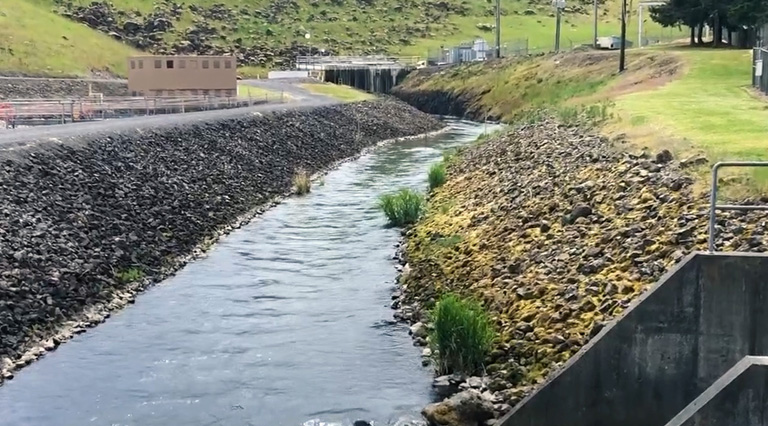The Office of Chehalis Basin (OCB) is currently studying ways that the Skookumchuck Dam—which sits at the midpoint of the Skookumchuck River—could be improved for flood damage reduction and/or fish passage.
OCB and the Chehalis Basin Board took interest in studying the Skookumchuck Dam after learning that TransAlta will be closing its final coal burner, which draws water from the dam, in 2025. The dam has operated since 1970.
About the Study
This early study will look into the feasibility of adjusting dam discharges, modifying the structure of the dam, or completely removing it. OCB will work with Anchor QEA to collect survey data and build models to evaluate options for the dam. OCB and Anchor QEA will also work with technical experts representing the cities of Centralia and Bucoda, the Confederated Tribes of the Chehalis Reservation, and experts in flooding and aquatic species. OCB has completed an initial report and a more detailed Phase 2 study:
Potential Flood Damage Reduction Benefit
While the Skookumchuck Dam was not designed and is not managed to reduce flooding on the Skookumchuck River, it has provided some benefit.
When the catastrophic flood of December 2007 hit the Chehalis River Basin, the reservoir behind the dam was unusually low, allowing it to hold back water that would have otherwise made flooding in Bucoda and Centralia even worse than it was.
The current study will examine how this partial, unintended flood reduction could be improved to provide greater benefit. (This will build on a study completed in 2012 by the U.S. Army Corps of Engineers.)
Fish Passage Limited
When the dam was built, the former Washington Department of Fisheries required the owners to build a fish hatchery and an associated fish capture and transportation facility. The intent of the hatchery was to offset the fish habitat lost to the dam, which included approximately:
- 4–5 miles of Chinook spawning habitat
- 8 miles of coho spawning habitat
- 20 miles of steelhead spawning habitat
The dam prevents most fish from traveling upstream. Until 2008, the only fish to travel upstream past the dam were steelhead that the Department of Fish and Wildlife (WDFW) captured and hauled during spawning season. Between 2008 and 2020, no fish were transported upstream of the dam. In 2020, WDFW once again trapped and hauled steelhead above the dam.
The current study will investigate whether changing discharges from the dam or improving the 50-year-old fish capture and transport facilities will benefit fish in the river. It will compare those benefits to a hypothetical removal of the dam.
Potential Impacts on Water Rights
The dam stores water during the winter, to be discharged during the summer, creating approximately 60 cubic feet per second (cfs) of water that is available year-round. TransAlta currently holds the right to use the water.
TransAlta used the water right to power two electrical power generation turbines until 2020, when it shut one of them down. TransAlta continues to use water to operate the remaining turbine. Though it plans to shut down the remaining turbine in the plant in the coming years, TransAlta established a water bank in 2021 that allows the company to maintain its right to beneficially use the water and to sell the right to others.
Should the dam be altered in a way that keeps TransAlta from storing enough water, there would be a reduction of water in the water bank for TransAlta to sell. Other water right users downstream, such as municipal water suppliers or farms relying on surface water irrigation, may also see their water availability impacted. If that happens, TransAlta and other water users may have to be compensated for the lost water right.
Next Steps
At this time, there are no planned changes to the dam. Upon reviewing the study results in early 2023, the Chehalis Basin Board may request additional studies, select an option to pursue further, or take no further steps. If the board decides it is interested in moving forward with a preferred option, any project will require additional design, environmental review, and permits ahead of construction.
Contact
If you’d like to learn more, please contact us!
Nat Kale
Principal Planner
nat.kale@ecy.wa.gov
(360) 706-4277

